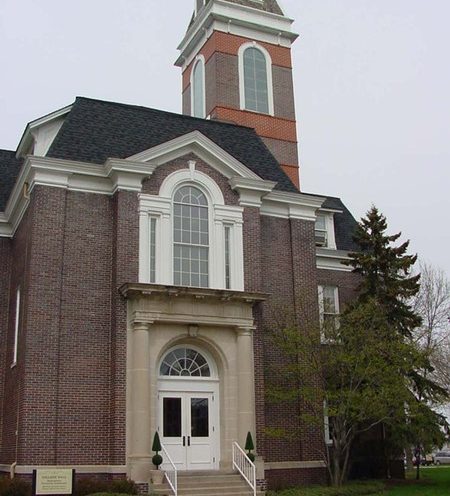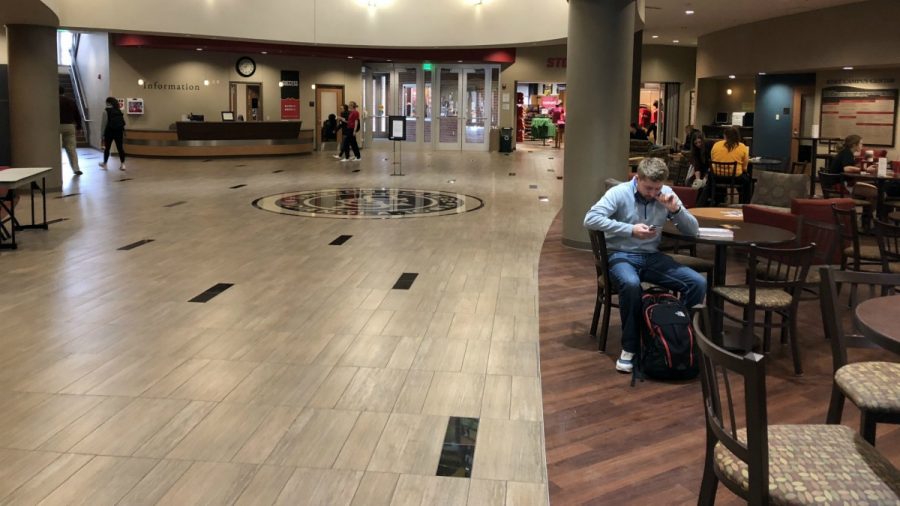College Hall is oldest on campus

Simpsonian file photo
April 14, 2004
College Hall is the oldest surviving building on campus – itsfoundation was laid over 136 years ago. There are a wide range ofghost stories and rumors about the building when its historyshould, literally, be set in stone.
Two popular tales about College Hall are that a ghost namedMildred haunts the building and that tunnels used to lead from itsbasement to other buildings on campus.
“Mildred’s Room”
The top floor of College Hall houses the financial aiddepartment, a conference room named the Red and Gold Room and asmall bedroom informally known as Mildred’s Room. It’s easy toimagine a woman living there in the past. A dress hangs in onecorner above a pair of old-fashioned black shoes while a perfumebottle, a pair of gloves and a small curling iron rest on thedresser.
Larry Cutts retired last year after working in Simpson’smaintenance department for over 20 years. He said the room wasdesigned to be an archives display and its appearance of a woman’sbedroom from Mildred’s time was probably coincidental.
Lazier said the room didn’t bother her.
“A lot of people don’t like to come up here,” said sophomore JenLazier. “They’re afraid of the room because of all the storiesabout it, but I don’t care. I’ve laid on Mildred’s bed and I’mstill here.”
Mildred Hedges was a 22-year-old freshman at Simpson in 1935when she lost her footing on the open stairwell at the south end ofCollege Hall and fell to her death. There are a wide range ofstories about the actual circumstances of Hedges’ death,though.
Lazier said it was raining the day she died, so the stairs werewet from students’ shoes and that caused the fatal accident. ColeZimmerman, the director of recruitment, said he always asksstudents which version of the story they want.
“There’s the romantic version,” said Zimmerman. “That one saysshe and her boyfriend got in a fight and he pushed her. There’sanother version that the stairs were too crowded and she just losther balance.”
Joe Walt wrote in “Beneath the Whispering Maples” that Hedgesstumbled and fell over the railing, hitting her head on a tablebefore landing. Walt said she was taken to a hospital where shedied later in the day.
Lazier said there is a red stain on the banister just above thesecond floor of College Hall that could be Hedges’ blood.
“It may not look like blood,” said Lazier. “But it’s been buffedand scrubbed at for years, so it could be hers.”
If Walt’s account is accurate, it’s unlikely the stain is fromHedges’ fall. He said she fell 18 feet to the floor, and the stainis much higher than 18 feet. To stain the banister, Hedges wouldhave had to fall from even higher.
“The Catacombs”
At the bottom of the stairs, near Mildred Hedges’ landing placeis the door to the basement of College Hall. It is locked nowbecause confidential student records are kept there, but it used tohold a popular student hangout called The Catacombs.
Jerry Oliver graduated from Simpson in 1965. He described whatthe basement coffee shop was like.
“It was very 1960s,” said Oliver. “Every Friday and Saturdaynight there’d be live guitar music or a poetry reading. Peanutshells just covered the floor.”
Oliver was surprised the basement was no longer open tostudents.
“Is nothing sacred?” he asked. “We loved that place.”
Oliver’s wife, Carol, said there were rumors that tunnels usedto lead to other buildings from College Hall while she wasattending Simpson.
“The tunnel theory is entirely possible,” she said. “Simpsoncould have even been part of the Underground Railroad but there’sreally no way to prove it for sure.”
At the foot of the basement stairs there are two short passagesthat stop abruptly after about six feet. Cutts said these shortcorridors could be the reason for the tunnel rumor.
“They look like the beginnings of tunnels, but they aren’t,”said Cutts. “That’s just the way the foundation was built.”
The two openings point east and west, toward the college’ssecond and third brick buildings, Wallace Hall and Mary BerryHall.
At the far end of the basement, a loose dirt opening leadstoward Hillman. Cutts said this was where the building’s steampipes used to run.
“That looks like it might be a tunnel, but I’m sure you can’tget anywhere by crawling into it,” said Cutts. “There never wereany tunnels you could crawl through on campus.”
Myth v. Fact
While the stories and tales abound, some remain skeptical aboutthem.
Zimmerman said he wasn’t sure there was truth in many of thetales about College Hall.
“I know everyone wants there to be some truth to these stories,”he said. “Even prospective students ask me about Mildred, but I’vebeen working here for over 20 years and I’ve never seen a light orheard a creak.”
Sarah Aubert, admissions systems specialist, said the storiesprobably scare more people than those who admit it.
“A lot of people won’t talk about it,” said Aubert. “They don’twant to say they’re spooked.”
Stories about College Hall are an established tradition atSimpson. Carol Oliver said it was common knowledge that thebuilding was haunted when she was in school.
“You just didn’t go there when it was really dark, and you neverwent alone,” said Oliver. “Some people claimed to see flickeringlights in the very top windows at night. Whether it’s all made upor not, I don’t know.”
Zimmerman said when he attended school here in the early 1970s,students would sneak into College Hall at night for variousreasons.
“Sometimes they’d sneak in to look for ghosts,” said Zimmerman.”I always thought that was how most of the rumors were started.Students would see someone else sneaking around the building andthink that was a ghost, or they’d see the flashlights from outsideand think that was a ghost.”
The stories about College Hall are just part of its longhistory; it has held classrooms, chapels, student centers, and evena theater. It was boarded up and abandoned for five years between1980 and 1985, but members of the Simpson community fought to savethe building. According to Zimmerman, College Hall has earned apermanent place at Simpson.
“We’ll never get rid of this building,” said Zimmerman. “It’sfar too important to tear down.”





